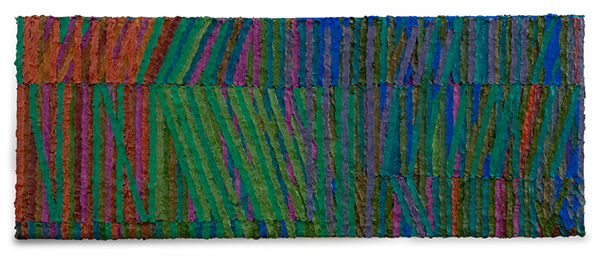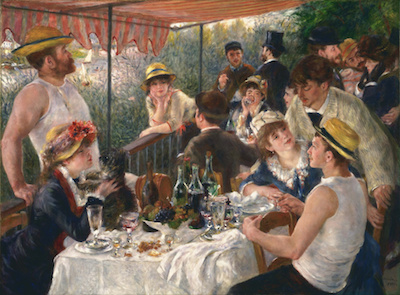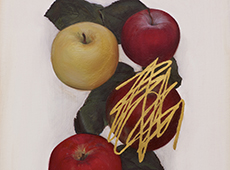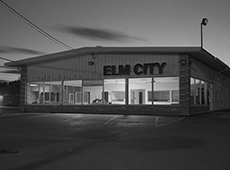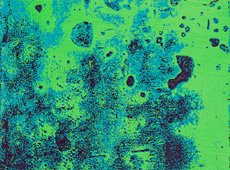To aim for a more complete expression of reality is not at odds with abstraction. Reality in abstract painting exists where what is seen impacts the body physically…
Brett Baker,
(Click to enlarge.)
Although there are other painters I feel closer to – Braque, de Staël, and Soutine are crucial to me – I offer a note on Renoir’s Luncheon of the Boating Party (1880-81) as my backstory, because it represents, for me, the ultimate of what a painter might achieve – a vision as large as the world. This painting is on my mind every day, and in many ways I chart my slow progress as a painter against the fullness of the world it presents.
An invisible breeze animates and orders Renoir’s picture. The airflow cannot be seen, but it can be felt moving through and around the figures, establishing their positions and gestures. The awning flaps and the trees sway helplessly. Even the light follows, flickering back and forth across surfaces as shadows shift with the wind. The luncheon barely holds the tablecloth in place. The air pushes, pulls, and lifts. A living, breathing, self-supporting structure, it raises the entire scene in three-dimensions, floating it in front of us as a tangible, experiential vision.
It was in front of Renoir’s picture that I recognized a truth: as an abstract painter, I need a model whose painterly world is vivid and, most importantly, expansive.
To aim for a more complete expression of reality is not at odds with abstraction. Reality in abstract painting exists where what is seen impacts the body physically, where space visually navigated can be felt. By this definition, Renoir’s painting is as abstract as any work ever painted. We understand the relationships of the painting through an invisible, natural force.
Pierre-Auguste Renoir,
(Click to enlarge)
Renoir’s vision for painting was as complex as the scene before him. In reaching towards an equally convincing expression, I am increasingly turning to the scene before me. My most recent works incorporate moments of perceptual painting to push repeating marks of uninflected color to their expressive limits.
As the painting develops the possible combinations of marks echo the myriad relations contained within a cone of vision. Each mark carries within its color and position a specific spatial location, pressure, and temperature, and each of these properties is multivalent – localized to itself and immediate neighbors while essential to the experiential whole of the painting.
To aim for a more complete expression of reality is not at odds with abstraction. Reality in abstract painting exists where what is seen impacts the body physically…
As an artist I don’t try to move forward in my work so much as expand outward the realm of what I can see. My ambition as a painter is to address an ever widening circle of experience with the goal of creating an art that, to paraphrase Clement Greenberg, is less like art and more like life.
[portfolio_slideshow id=7820 exclude=”7837,7836,7833,7844,7845″]
Brett Baker is a painter who lives and works in Durham, North Carolina. In addition to being an artist, he is the editor of Painters’ Table (painters-table.com), an online painting magazine, and he also writes frequently about art.
Editor’s Recs
Read: Sharon Butler, Small Work: Brett Baker. Two Coats of Paint (2015)
Read: Brett Baker in Conversation with Julia Schwartz, Figure/Ground (2013)
Read: James Panero, Gallery Chronicle, The New Criterion (2013)
Watch: Brett Baker in Conversation with Zachary Keeting and Christopher Joy, Gorkys Granddaughter (2012)
Visit: Painters’ Table, Brett Baker’s (invaluable!) daily digest of the painting blogosphere.
Visit: brettbakerpaintings.com
Gallery Site: Brett Baker at Elizabeth Harris Gallery
Subscribe to Tilted Arc
If you like this story, please consider subscribing. We are sticklers for privacy.
We will never sell or share your e-mail address.

